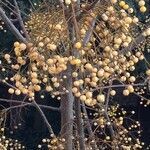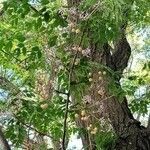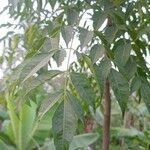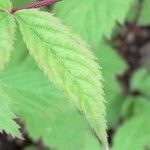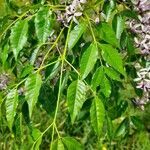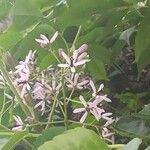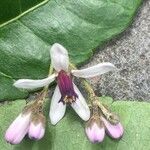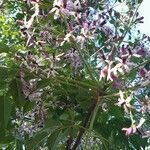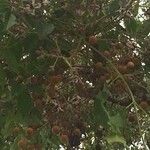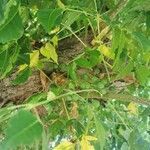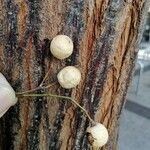Trees to 10 m tall, deciduous. Bark brownish gray, longitudinally exfoliating. Branches spreading; branchlets with leaf scars. Leaves odd-pinnate, 2-pinnate or 3-pinnate, 20-40 cm; leaflets opposite; leaflet blades ovate, elliptic, or lanceolate, 3-7 × 2-3 cm but terminal one usually slightly larger, both surfaces with stellate trichomes when young but glabrescent, secondary veins 12-16 on each side of midvein, outspread and ascending, base ± oblique and cuneate to broadly cuneate, margin crenate or sometimes entire, apex shortly acuminate. Thyrses ± ca. 1/2 as long as leaves, glabrous or covered with short lepidote pubescence. Flowers fragrant. Calyx 5-parted; sepals ovate to oblong-ovate, outside puberulent, apex acute. Petals lilac-colored, obovate-spatulate, 0.9-1.3 cm, both surfaces puberulent but usually outside more densely so. Staminal tube purple, 7-8 mm, with longitudinal stripes, glabrous or subglabrous, apical margin with 10 narrow lobes; lobes conic, further 2-or 3-lobed; anthers 10, inserted on inner side of lobes and alternate to lobes, narrowly elliptic, apex slightly mucronulate. Ovary spherical, glabrous, 5-8-locular, with 2 ovules per locule; style acerose; stigma capitate, not included within filament tube, apex 5-dentate. Drupe globose to ellipsoid, 1-3 × 0.8-1.5 cm; endocarp ligneous. Seed ellipsoid. Fl. Mar-May, fr. Oct-Dec.
Medium-sized rapidly growing short-lived tree up to 15 m. tall, sometimes flowering as a shrub; bark grey-brown, smooth.. Leaves 2(–3)-pinnate; petiole and rhachis up to 40 cm. long; leaflets opposite or subopposite, ± lanceolate, up to 5.5 × 2.5 cm., apex acuminate or subacuminate, base asymmetric, margin rather deeply crenate or serrate, lower surface sparsely puberulous, glabrescent, petiolules up to 0.7 cm. long.. Inflorescence a large many-flowered axillary cymose panicle; flowers sweetly scented.. Calyx 0.25 cm. long, densely stellate puberulous.. Petals spathulate, up to 0.8 × 0.3 cm., pale lilac, sparsely puberulous outside with simple hairs, glabrous inside except for a few hairs towards apex.. Staminal tube up to 0.7 cm. long, dark purple, glabrous outside, hairy inside, especially in the upper half; appendages ± 0.1 cm. long.. Ovary less than 0.1 cm. in diameter, 5(–7)-locular; style 0.45 cm. long.. Drupe up to 2 × 1.5 cm., pale yellow; putamen with ± 5 longitudinal ridges and indistinct apical and basal depressions.. Fig. 4.
Deciduous tree to 40 m tall; bole to at least 60 cm diam.; bark fissured and scaling with age; leafy twigs ±clothed with fulvous stellate hairs. Leaves 15–80 cm long with 3–7 pairs of pinnae, each with 3–7 leaflets, the most basal sometimes replaced by short pinnae with a few pairs of leaflets, usually subglabrous; petiole 8–30 cm long; leaflets ovate or oblong-lanceolate to elliptic, usually 3–6 cm long, 1–2.5 cm wide, entire to serrate. Thyrses 10–22 cm long, twice-branched with fascicles of scented flowers. Calyx c. 2 mm diam.; lobes c. 2 mm long. Petals narrowly oblong, 6–10 mm long, 2 mm wide, white to lilac or bluish. Drupe plum-shaped, 2–4 cm long, 1–2 cm wide, yellow-brown. Seed smooth, brown.
A moderate sized tree. It grows 6-16 m high. It can spread 3-12 m wide. The trunk is round and the branches spread out widely. The bark is greyish-brown. The bark has long shallow cracks along the length. The leaves are alternate. They are twice divided and bright green. The leaflets are sword shaped and have teeth along the edge. They are 7-8 cm long by 2 cm wide. The leaf base has unequal sides. The flowers are lilac and have a honey scent. The occur in long open clusters in the axils of leaves. These are about 18-20 cm long. The fruit is fleshy and round. It is about 1-1.5 cm across. It is smooth and yellow. There are 4 tiny seeds in a very hard shell.
Medium-sized rapidly growing short-lived deciduous tree up to 15 m tall, sometimes flowering as a shrub. Leaves up to 400 mm long; leaflets up to 55 x 25 mm, more or less lanceolate, apex acuminate or subacuminate, margin rather deeply crenate or serrate; lower surface sparsely puberulous, glabrescent. Calyx 2.5 mm long, densely stellate-puberulous. Petals up to 8 x 3 mm, pale lilac, spathulate. Staminal tube up to 7 mm long, dark purple, glabrous outside, hairy inside; appendages c. 1 mm long. Drupe pale yellow, up to 20 x 10 mm.
Tree, 1-30 m high; indumentum of simple, glandular and tufted-stellate hairs. Leaves 2-or 3-pinnate; leaflets crenate or serrate, imparipinnate. Flowers: bisexual and male on same individual (polygamous); in panicles. Petals imbricate, lilac, perfumed. Staminal tube narrowly cylindrical; anthers 10, shortly apiculate, purplish. Disc annular. Flowering time Sept.-Nov. Fruit a 3-8-locular drupe; locules usually 1-seeded; green turning yellow, persisting after the leaves fall.
Deciduous tree, up to 15 m high. Leaves 2-or 3-pinnate, imparipinnate; leaflet blade narrowly ovate, up to 55 x 25 mm, base asymmetrical, apex acuminate, margins serrate. Flowers: inflorescence a panicle, sprays heavily scented; staminal tube purplish; petals ± 10 mm long, pale lilac to dark purple; Aug.-Feb. Fruit a drupe, thinly fleshy, turning yellow and wrinkled with age.
Leaves usually 2-, rarely 3-pinnate; petiole and rhachis up to 40 cm. long; leaflets up to 5·5 × 2·5 cm., opposite or subopposite, more or less lanceolate, apex acuminate or subacuminate, base asymmetric, margin rather deeply crenate or serrate, sparsely puberulous, glabrescent; petiolules up to 7 mm. long.
Tree to 15 m, with broadly rounded crown; lfls numerous, ovate or lance-ovate, 3–7 cm, serrate, acuminate; fls lilac, in axillary panicles, the slender, spreading pet 1 cm; fr yellow, 1.5 cm thick, persistent; 2n=28. Native of Asia, escaped from cult. in se. U.S., as far n. as se. Va.
Deciduous tree, up to 15 m high. Leaves 2-or 3-pin-nate; leaflets lanceolate, up to 55 x 25 mm, apex acuminate, base asymmetrical. Inflorescence a panicle. Fruit a 3-8-locular drupe, yellow. Flowers pale lilac.
Petals up to 8 × 3 mm., pale lilac, spathulate, sparsely puberulous outside with simple hairs, glabrous inside except for a few hairs towards apex.
Staminal tube up to 7 mm. long, dark purple, glabrous outside, hairy inside, especially in the upper half; appendages c. 1 mm. long.
Medium-sized rapidly growing short-lived deciduous tree up to 15 m. tall, sometimes flowering as a shrub; bark grey-brown, smooth.
Flowers sweet-scented, in large many-flowered axillary cymose panicles.
Ovary less than 1 mm. in diam., 5 (7)-locular; style 4–5 mm. long.
Introduced for ornament and known as Persian Lilac.
Calyx 2·5 mm. long, densely stellate-puberulous.
Abundant panicles of lilac flowers
Drupe up to 2 × 1–5 cm.
A small tree
